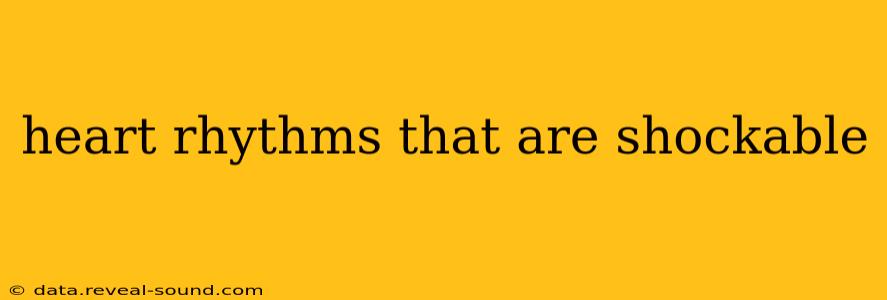Sudden cardiac arrest (SCA) is a life-threatening emergency where the heart suddenly stops beating effectively. Defibrillation, a process using a defibrillator to deliver an electric shock, can restore a normal heart rhythm in certain situations. However, it's crucial to understand that defibrillation is only effective for specific, shockable heart rhythms. This article will explain these rhythms and the importance of rapid intervention.
What is Defibrillation?
Defibrillation uses a controlled electrical shock to interrupt the chaotic electrical activity causing the heart to fibrillate (quiver ineffectively) and allow it to potentially resume a normal rhythm. This is a time-sensitive procedure, and the sooner it's applied, the greater the chance of survival.
Shockable Heart Rhythms: Ventricular Fibrillation (VF) and Pulseless Ventricular Tachycardia (pVT)
The two primary shockable heart rhythms are:
Ventricular Fibrillation (VF)
VF is a chaotic, disorganized electrical activity in the ventricles (the heart's lower chambers). The heart doesn't pump blood effectively, leading to a lack of pulse and loss of consciousness. On an electrocardiogram (ECG), VF appears as irregular, wavy lines with no discernible P waves, QRS complexes, or T waves. It looks like a chaotic squiggle.
Pulseless Ventricular Tachycardia (pVT)
pVT is a rapid, regular heart rhythm originating in the ventricles. While the heart is beating rapidly, it’s not pumping blood effectively because the rhythm is too fast and disorganized. The patient will be pulseless and unresponsive. On an ECG, pVT shows rapid, wide QRS complexes without detectable P waves.
Heart Rhythms That Are NOT Shockable
It's equally crucial to understand which rhythms are not shockable. Administering a shock to a non-shockable rhythm can be harmful. These include:
- Asystole (flatline): There's no electrical activity in the heart. CPR and medications are the primary interventions.
- Pulseless Electrical Activity (PEA): There's electrical activity, but the heart isn't pumping blood effectively. CPR and medications are the primary interventions.
- Organized Rhythms with a Pulse: Rhythms like sinus tachycardia (fast heart rate) or supraventricular tachycardia (rapid heart rate originating above the ventricles) may require treatment, but defibrillation isn't appropriate.
How Do Emergency Responders Determine Shockable Rhythms?
Emergency Medical Technicians (EMTs) and paramedics use ECGs to quickly analyze the heart rhythm. Automated External Defibrillators (AEDs) also analyze the rhythm and provide voice prompts, guiding lay rescuers on whether a shock is advised. Accurate rhythm identification is critical for successful resuscitation.
What is the difference between VF and pVT?
The main difference lies in the regularity of the rhythm. VF is completely chaotic and disorganized, while pVT is a rapid but relatively regular rhythm. Both, however, result in no effective blood flow, necessitating immediate defibrillation.
Can someone survive VF or pVT?
Survival from VF and pVT depends on factors like the time to defibrillation, the presence of bystanders trained in CPR, and the patient’s overall health. Early defibrillation significantly increases the chance of survival.
What happens after defibrillation?
After a successful defibrillation, the heart may resume a normal rhythm. However, continuous monitoring and further medical intervention are essential. CPR will likely be continued until a normal heart rhythm is established and the patient is stable.
How can I learn more about CPR and defibrillation?
Many organizations offer CPR and AED training courses. Check with your local community center, hospital, or Red Cross chapter for information on classes near you. Learning these life-saving skills can significantly improve the survival rate for victims of sudden cardiac arrest.
This information is for educational purposes only and should not be considered medical advice. Always consult with a healthcare professional for any health concerns.
